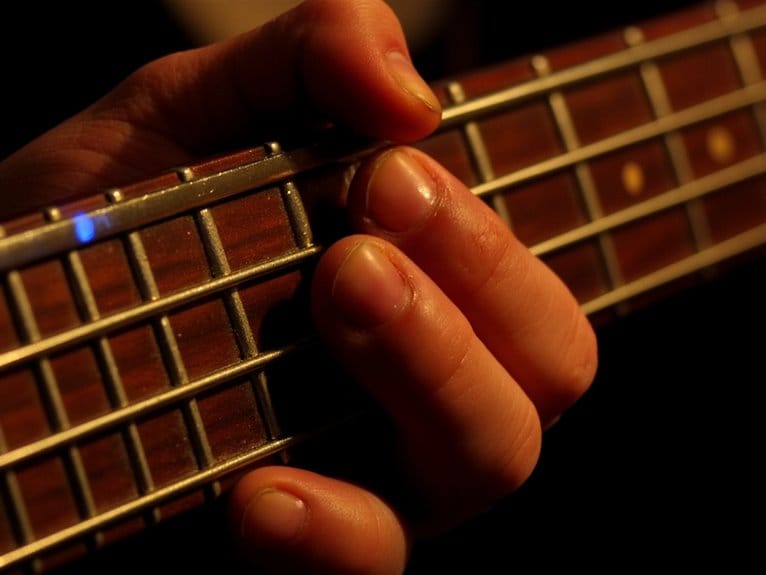Walking Bass Lines: Jazz Fundamentals for All Genres
You’ll build walking bass lines using steady quarter notes that outline chord tones-roots, thirds, fifths, and sevenths-while incorporating chromatic passing notes between strong beats. Master essential progressions like ii-V-I movements, blues changes, and circle of fifths patterns, then emphasize beats two and four to create that signature swing feel. Whether you’re playing piano, guitar, or bass, these techniques work across jazz, blues, and rock genres by establishing rhythmic stability and harmonic clarity. Discover how proper voice leading transforms your musical foundation.
We are supported by our audience. When you purchase through links on our site, we may earn an affiliate commission, at no extra cost for you. Learn more.
Notable Insights
- Walking bass lines use steady quarter notes and chord tones to create rhythmic stability and harmonic foundation across jazz and other genres.
- Construction relies on placing roots and fifths on strong beats while using chromatic passing notes for smooth melodic movement between chords.
- Master essential progressions like ii-V-I, circle of fifths, and blues changes to build solid harmonic understanding and voice leading skills.
- Develop swing feel by emphasizing beats two and four while coordinating with drummers to create forward momentum and ensemble cohesion.
- Apply walking bass techniques across instruments including piano left hand, guitar accompaniment, and horn section counterlines for versatile musical arrangements.
The Anatomy of Walking Bass: Quarter Notes and Harmonic Foundation
Walking bass lines form the rhythmic and harmonic backbone of jazz, and if you’ve ever wondered why they sound so compelling, it’s because they’re built on a deceptively simple foundation of steady quarter notes that create both forward momentum and harmonic clarity.
These four-to-the-bar quarter notes establish rhythmic stability while outlining essential chord tones-roots, thirds, fifths, and sevenths-that define each harmony’s character.
What makes this approach brilliant is how bassists avoid repeating the same pitch consecutively, maintaining melodic interest through strategic note choices that bridge between chords using semitones, whole tones, or perfect fifths.
This creates seamless harmonic connections while the consistent pulse coordinates with drummers to generate that unmistakable swing groove that propels music forward with walking-like momentum.
Just as harmonic content improves the perception of sound quality in budget cymbals, the strategic use of chord extensions and passing tones enhances the harmonic richness of walking bass lines across all musical genres.
Construction Techniques: Chord Tones, Passing Notes, and Voice Leading
Three essential elements work together to create compelling walking bass lines: chord tones that establish harmonic foundation, passing notes that provide melodic connection, and voice leading principles that secure smooth changes between chords.
You’ll want to place roots and fifths on strong beats, particularly beats one and three, while using chromatic approaches to lead into these foundational tones.
Passing notes fill the gaps on weaker beats, creating forward motion through half-step movements and scalar connections.
Voice leading guarantees your melodic shapes flow smoothly between chord changes, minimizing awkward leaps while maintaining harmonic clarity.
Master these techniques by practicing arpeggiated triads first, then gradually incorporating chromatic passing tones and neighbor notes to develop more sophisticated, professional-sounding bass lines.
Essential Progressions: Circle of Fifths, Blues, and Ii-V-I Movements
Once you’ve mastered the basic construction techniques, you’ll need to tackle the essential progressions that form jazz’s harmonic backbone: the circle of fifths, blues changes, and ii-V-I movements.
The circle of fifths becomes your roadmap for understanding circle relationships between keys, showing how adjacent positions create smooth harmonic modulation opportunities.
Blues progressions, built on I-IV-V foundations, provide repetitive cycles perfect for walking lines that emphasize strong root movements through fifths.
The ii-V-I progression represents jazz’s most fundamental sequence, moving systematically through circle relationships with natural voice leading. Each chord steps a fifth apart, creating tension and resolution that walking bass lines can exploit through chord tones and strategic passing notes, establishing groove while outlining harmonic frameworks essential for improvisation.
For beginners developing these skills, starting with a quality split-coil pickup instrument ensures the warm, versatile tones necessary to clearly hear chord progressions and practice fundamental bass techniques across various musical genres. Additionally, exploring different techniques on a variety of instruments, including 6 string bass guitars, can expand your playing style and musical vocabulary. These instruments offer added range and creativity, allowing beginners to experiment with more complex bass lines. As you become comfortable with the fundamentals, you’ll find that your musical expression can grow exponentially with each practice session. It’s also beneficial to understand the various bass pickup types explained, as this knowledge can help you choose the right instrument for your sound preferences. Each pickup type offers unique tonal qualities that can significantly influence your playing experience and the overall character of your music. Experimenting with these pickups can lead to exciting discoveries and innovations in your personal style.
Swing Feel and Rhythmic Interplay With the Rhythm Section
While mastering chord progressions provides the harmonic foundation for your walking lines, developing proper swing feel and rhythmic interplay with the rhythm section transforms those notes from mechanical exercises into living, breathing jazz.
Your bass creates swing dynamics through strategic emphasis on beats two and four, working with the drummer’s ride cymbal patterns to establish that characteristic forward momentum. This rhythmic collaboration requires you to think beyond simply outlining chord changes-you’re anchoring the entire ensemble’s time feel.
Effective walking lines employ chromatic approach notes and scale-based connections that resolve on strong beats, creating horizontal motion rather than vertical chord marking.
When you emphasize those off-beats and maintain consistent quarter-note pulse, you’re giving the drummer space to play “in the cracks” while supporting the pianist’s comping patterns, ultimately producing cohesive swing groove.
Practical Applications Across Instruments and Musical Styles
Although walking bass lines originated in jazz, I’ve found that their versatility extends far beyond traditional swing music, adapting to virtually every instrument and genre with remarkable flexibility.
These instrument adaptations reveal fascinating genre variations that showcase the technique’s universal appeal.
- Piano players employ walking lines in their left hand while maintaining melodic freedom in the right, creating thorough harmonic foundations that work equally well in blues, country, and rock contexts.
- Guitarists combine bass notes with chordal accompaniment, adapting the percussive nature of their instrument to emulate traditional bass walking patterns while adding rhythmic complexity.
- Horn sections occasionally use walking lines melodically during solos, though they’re more effective as counterlines rather than continuous bass functions in ensemble settings.
On a final note
You’ve now got the essential framework for crafting compelling walking bass lines that’ll work across any musical context. While I can’t promise you’ll sound like Ray Brown overnight, these quarter-note foundations, chord-tone constructions, and rhythmic principles will serve you well whether you’re playing upright bass in a jazz combo or programming synthesized lines in electronic music. Practice these concepts consistently, and you’ll develop that essential harmonic vocabulary.







